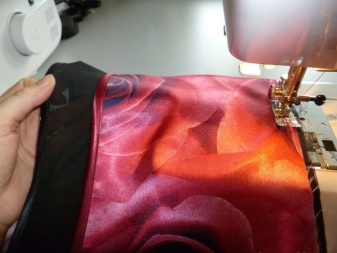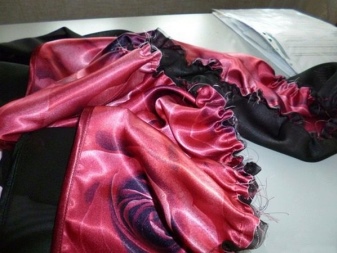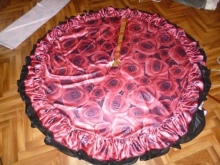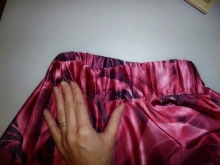The skirt, which is called gypsy, is represented by a long free model that does not constrain movements. It is often bought for dancing or carnival images. The main feature of gypsy skirts is the ability to raise the edges of the product with straightened hands.
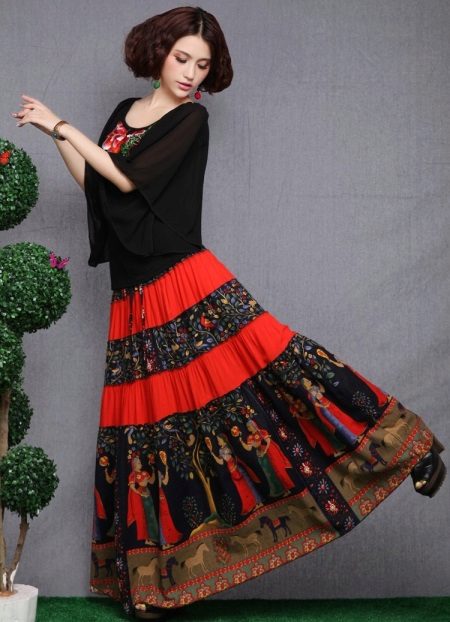
Such a skirt looks good on any figure and combines wonderfully with things in the ethno and casual styles. Another advantage of the gypsy skirt is the ability to make it with your own hands, even if the experience of sewing clothes is minimal.
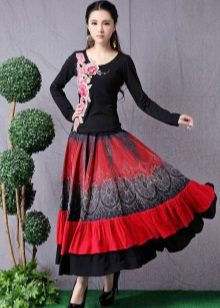
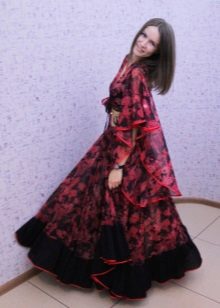
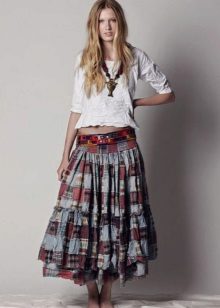
Fabrics
A gypsy skirt is usually sewn from bright and easily draped material. It is important that the fabric does not show through and crumple. Satin, staple, blended fabrics, rayon, or polyester fabric are well suited to these conditions.

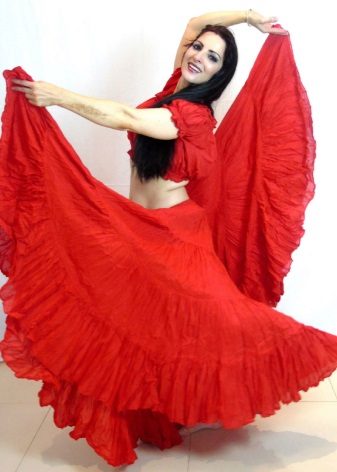
The color of the fabric is most often represented by a floral ornament. If a monophonic material is used for a gypsy skirt, then contrasting color ribbons, braid, sequins, beads and embroidery are used in its decoration. Geometric print fabrics for gypsy skirts are not suitable.
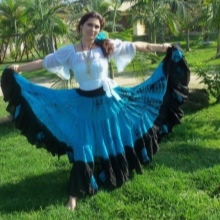
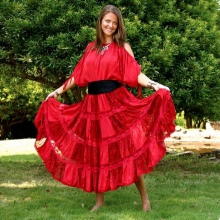

For lining the gypsy skirt, the same fabric can be used as for the main part, but more often the petticoat is sewn from a suitable in color, but cheaper material.

Styles
The gypsy skirt is a wide long model. Most often, such a skirt is sewn in the “sun” style (it is made double or 2.5) with a frill on the bottom.

Multilayer skirts and blades are also in demand. The rim in a gypsy skirt can be a little gathered or represented by a lot of flounces that are cut along the oblique. In addition, the frill is a single layer or sewn in several layers.
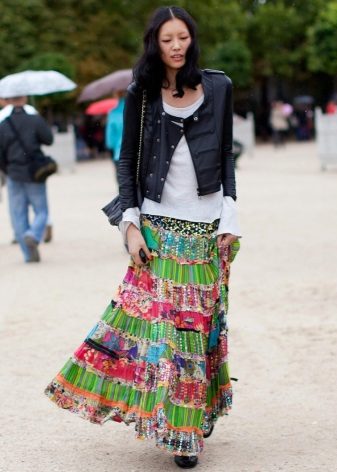

The length of the skirt varies from products to the floor to models whose hem extends along the line of the ankles. For splendor, a fishing line can be sewn into the hem (it is sewn at the junction of the main part of the skirt and frill).Such a skirt should cover the legs, but at the same time not hamper the movements. The smell of sewing gypsy skirts is not applied.
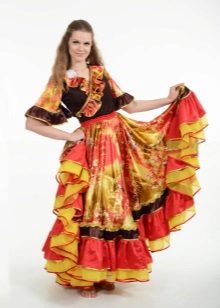
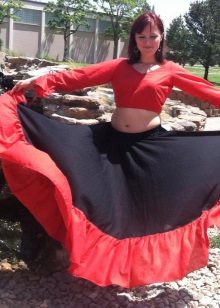

A belt for such a skirt is sewn of medium width. They try to make it without elastic so that the product does not slip in the dance. To make the belt stiffer, it is treated with non-woven fabric, and for the convenience of putting on a skirt, zipper is sewn into the belt.
You can make a belt with ties at the side, with a small cut on the skirt itself, to dress more conveniently. And if you still decide to use a cord, let it be tight and not too narrow.
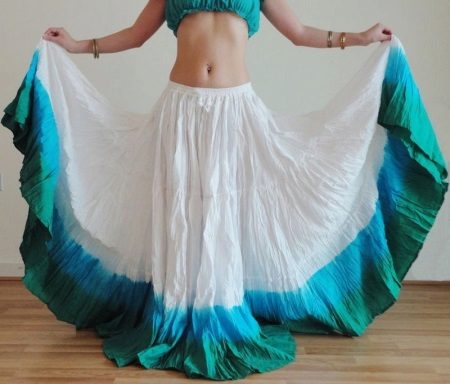
What to wear?
If the gypsy skirt is part of a themed or dance costume, it is usually complemented with a tight blouse. This blouse is a short model that covers the stomach. Ruffles are usually present on the sleeves of the blouse.

You can also pick up a plain T-shirt for a bright gypsy skirt, paying attention to additional accessories. This image goes well with a shawl of bright color, as well as with clinking bracelets, large earrings and bright beads.
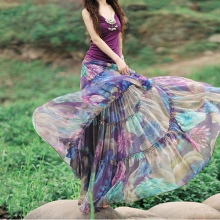
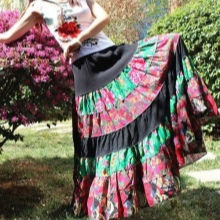
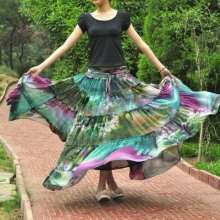
Everyday models of gypsy skirts can be worn with T-shirts and tops in a contrasting shade or matching the skirt. A nice addition is a corset, and in cool weather, such a skirt is quite organically combined with a long knitted sweater.


The most suitable shoes for gypsy skirts are sandals or sandals. They can be on low speed or wedges. If you want to visually increase growth, it is recommended that shoes with heels.

How to sew with your own hands
The preparatory stage in the independent manufacture of a gypsy skirt will be the purchase of all necessary materials. In addition to fabric, you need to purchase a slanting inlay, threads and non-woven.
Patterns
To make a pattern, you first need to take measurements. In addition to measuring the circumference of the waist and hips, you should also determine the desired length of the skirt. To build a pattern, the internal radius of the part is first calculated. To do this, the waist circumference is divided into 2 pi numbers, that is, 6.28.
For example, with a waist circumference of 63 cm, we divide this figure by 6.28 and get 10 cm. This will be the radius for one “sun” pattern, and since the style for a gypsy skirt requires two “suns”, divide the resulting radius by two and get 5 cm. This will be the internal radius of the part, which we will designate on paper.
From it we postpone the length of the skirt and draw a second radius. As a result, we get either two semicircles, if the length of the skirt, added to the radius, will be more than 74 cm (it will not work to fold the fabric), or a quarter of the “sun”, when opening which the fabric is folded four times. The resulting cutting in such a quarter circle is cut along the shared thread.
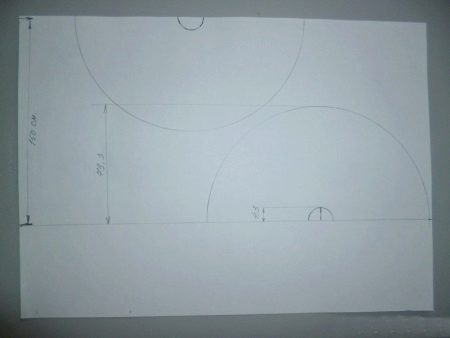
On average, about 9-13 m of fabric is required for a skirt, if its width is 150 cm. From this quantity two “suns” are obtained and the material remains for frills. The rim is made from 10 to 25 cm wide. It requires a fabric ribbon that will be twice as long as the hem of the skirt. For the belt, a rectangle is cut out from the main fabric and one more from non-woven fabric.
Sewing
Do these stages of making gypsy skirts with your own hands:
- Cut fabric. First you need to attach the pattern to the material and circle it with chalk, taking into account the allowances for the seams. Next, cut out the details of the main skirt, and then separately cut out the frill and belt.
- Making the main part of the skirt. Having folded the product panels with their faces facing each other, you need to flash their side seams, then zigzag the edges or overlock them.
- Making a frill and sewing it on a skirt. The lower part of the frill should be bent and stitched or processed with an oblique trim. The frill ribbons sewn together are picked up and evenly sewn to the main part of the skirt.
- Making a belt and sewing it on a skirt.
- Sewing a petticoat, if it is provided in the model.
- Dressing the skirt, washing and ironing it.

